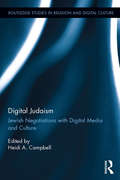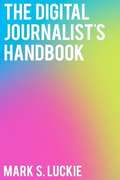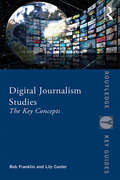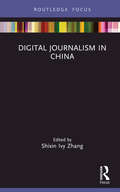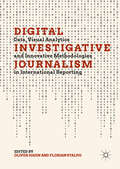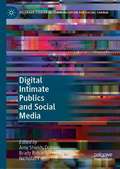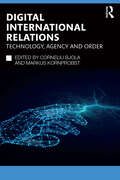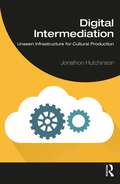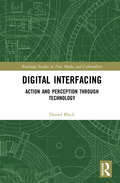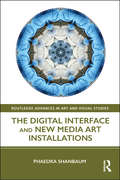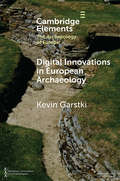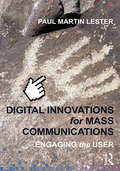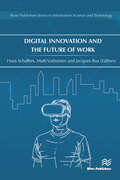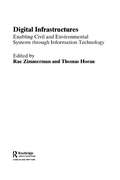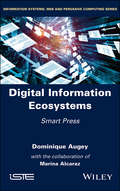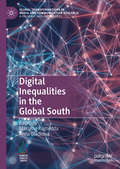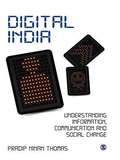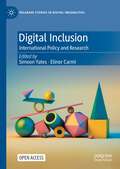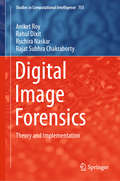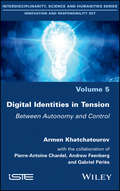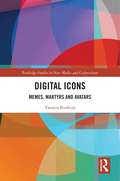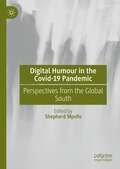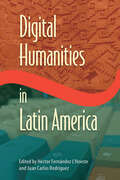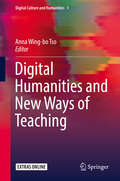- Table View
- List View
Digital Judaism: Jewish Negotiations with Digital Media and Culture (Routledge Studies in Religion and Digital Culture)
by Heidi A. CampbellIn this volume, contributors consider the ways that Jewish communities and users of new media negotiate their uses of digital technologies in light of issues related to religious identity, community and authority. Digital Judaism presents a broad analysis of how and why various Jewish groups negotiate with digital culture in particular ways, situating such observations within a wider discourse of how Jewish groups throughout history have utilized communication technologies to maintain their Jewish identities across time and space. Chapters address issues related to the negotiation of authority between online users and offline religious leaders and institutions not only within ultra-Orthodox communities, but also within the broader Jewish religious culture, taking into account how Jewish engagement with media in Israel and the diaspora raises a number of important issues related to Jewish community and identity. Featuring recent scholarship by leading and emerging scholars of Judaism and media, Digital Judaism is an invaluable resource for researchers in new media, religion and digital culture.
The Digital Journalist's Handbook
by Mark S. LuckieThe Digital Journalist's Handbook is your guide to the tools you need to know to thrive in today's digital newsroom. This unique how-to book provides simple explanations of complex technologies and provides examples of how journalists can incorporate them into their stories and reporting. The Handbook is composed of 12 chapters, each dedicated to a different tool in the digital journalist's toolbox. Chapters include "Writing for the Web," "Blogging," "Photography," "Audio," "Audio Slideshows," "Video," "Web Design," "Social Networking," "Data Visualization," and "Flash," as well as a glossary with definitions of more than 130 technical terms and phrases commonly used in digital journalism. The Handbook is also fully illustrated and contains diagrams and guidelines of everything from the layout of a typical blog to the features found on a digital audio recorder. In addition, each chapter includes links to online resources, tutorials, and examples of every technology mentioned in the book. The Digital Journalist's Handbook is a must-read for both novice digital journalists and tech-savvy experts.
Digital Journalism Studies: The Key Concepts (Routledge Key Guides)
by Bob Franklin Lily CanterDigital Journalism Studies: The Key Concepts provides an authoritative, research-based "first stop-must read" guide to the study of digital journalism. This cutting-edge text offers a particular focus on developments in digital media technologies and their implications for all aspects of the working practices of journalists and the academic field of journalism studies, as well as the structures, funding and products of the journalism industries. A selection of entries include the topics: Artificial intelligence; Citizen journalism; Clickbait; Drone journalism; Fake news; Hyperlocal journalism; Native advertising; News bots; Non-profit journalism; User comment threads; Viral news; WikiLeaks. Digital Journalism Studies: The Key Concepts is an accessible read for students, academics and researchers interested in Digital Journalism and Digital Journalism Studies, as well as the broader fields of media, communication and cultural studies.
Digital Journalism in China (Disruptions)
by Shixin Ivy ZhangThis edited collection brings together journalism scholars from mainland China, Hong Kong, the UK and Australia to address a variety of pressing issues and challenges facing digital journalism in China today. While China shares certain affinities with the digital disruption of media in other settings, its experience and articulation of change is ultimately unique. This volume explores the implications of digital media technologies for journalists’ professional practice, news users’ consumption and engagement with news, as well as the shifting institutional, organizational and financial structures of news media. Drawing on case studies and quantitative and qualitative approaches, contributors address questions concerning: whether China is witnessing ‘disruptive’ or ‘sustainable’ journalism; if, and in what ways, digital technologies may disrupt journalism; and whether Chinese digital journalism converges with or diverges from Western experiences of digital journalism. Digital Journalism in China is an important addition to the literature on digital journalism, comparative media analysis, the Chinese Communist Party’s social media strategies, tabloidization trends, and the conflict between newsroom and classroom in journalism education, and will be of interest to advanced students, scholars, and practitioners alike.
Digital Investigative Journalism: Data, Visual Analytics and Innovative Methodologies in International Reporting
by Oliver Hahn Florian StalphIn the post-digital era, investigative journalism around the world faces a revolutionary shift in the way information is gathered and interpreted. Reporters in the field are confronted with data sources, new logics of information dissemination, and a flood of disinformation. Investigative journalists are working with programmers, designers and scientists to develop innovative tools and hands-on approaches that assist them in disclosing the misuse of power and uncovering injustice. This volume provides an overview of the most sophisticated techniques of digital investigative journalism: data and computational journalism, which investigates stories hidden in numbers; immersive journalism, which digs into virtual reality; drone journalism, which conquers hitherto inaccessible territories; visual and interactive journalism, which reforms storytelling with images and audience perspectives; and digital forensics and visual analytics, which help to authenticate digital content and identify sources in order to detect manipulation. All these techniques are discussed against the backdrop of international political scenarios and globally networked societies. This edited volume, written by renowned international media practitioners and scholars, is full of illuminating insights into digital investigative journalism and addresses professional journalists, journalism researchers and students.
Digital Intimate Publics and Social Media (Palgrave Studies in Communication for Social Change)
by Nicholas Carah Brady Robards Amy Shields DobsonThis book explores emergent intimate practices in social media cultures. It examines new digital intimacies as they are constituted, lived, and commodified via social media platforms. The study of social media practices has come to offer unique insights into questions about what happens to power dynamics when intimate practices are made public, about intimacy as public and political, and as defined by cultural politics and pedagogies, institutions, technologies, and geographies. This book forges new pathways in the scholarship of digital cultures by fusing queer and feminist accounts of intimate publics with critical scholarship on digital identities and everyday social media practices. The collection brings together a diverse range of carefully selected, cutting-edge case studies and groundbreaking theoretical work on topics such as selfies, oversharing, hook-up apps, sexting, Gamergate, death and grief online, and transnational family life. The book is divided into three parts: ‘Shaping Intimacy’, ‘Public Bodies’, and ‘Negotiating Intimacy’. Overarching themes include identity politics, memory, platform economics, work and labour, and everyday media practices.
Digital International Relations: Technology, Agency and Order (Routledge Studies in Conflict, Security and Technology)
by Corneliu Bjola Markus KornprobstThis book analyses how digital transformation disrupts established patterns of world politics, moving International Relations (IR) increasingly towards Digital International Relations. This volume examines technological, agential and ordering processes that explain this fundamental change. The contributors trace how digital disruption changes the international world we live in, ranging from security to economics, from human rights advocacy to deep fakes, and from diplomacy to international law. The book makes two sets of contributions. First, it shows that the ongoing digital revolution profoundly changes every major dimension of international politics. Second, focusing on the interplay of technology, agency and order, it provides a framework for explaining these changes. The book also provides a map for adjusting the study of international politics to studying International Relations, making a case for upgrading, augmenting and rewiring the discipline. Theory follows practice in International Relations, but if the discipline wants to be able to meaningfully analyse the present and come up with plausible scenarios for the future, it must not lag too far behind major transformations of the world that it studies. This book facilitates that theoretical journey. This book will be of much interest to students of cyber-politics, politics and technology, and International Relations.
Digital Intermediation: Unseen Infrastructure for Cultural Production
by Jonathon HutchinsonDigital Intermediation offers a new framework for understanding content creation and distribution across automated media platforms – a new mediatisation process. This book draws on empirical and theoretical research to carefully identify and describe a number of unseen digital infrastructures that contribute to a predictive media production process through technologies, institutions and automation. Field data is drawn from several international sites, including Los Angeles, San Francisco, Portland, London, Amsterdam, Munich, Berlin, Hamburg, Sydney and Cartagena. By highlighting an increasingly automated content production and distribution process, this book responds to a number of regulatory debates on the societal impact of social media platforms. It highlights emerging areas of key importance that shape the production and distribution of social media content, including micro-platformisation and digital first personalities. This book explains how technologies, institutions and automation are used within agencies to increase exposure for the talent they manage while providing inside access to the processes and requirements of producers who create content for platform algorithms. Finally, it outlines user agency as a strategy for those who seek diversity in the information they access on automated social media content distribution platforms. The findings in this book provide key recommendations for policymakers working within digital media platforms and will be invaluable reading for students and academics interested in automated media environments.
Digital Interfacing: Action and Perception through Technology (Routledge Studies in New Media and Cyberculture)
by Daniel BlackThis book takes the interface – or rather to interface, a process rather than a discrete object or location – as a concept emblematic of our contemporary embodied relationship with technological artefacts. The fundamental question addressed by this book is: How can we understand what it means to perceive or act upon the world as a body–artefact assemblage? Black works to clarify the role of artefacts of all kinds in human perception and action, then considers the ways in which new digital technologies can expand and transform this capacity to change our mode of engagement with our environment. Throughout, the discussion is grounded in specific technologies – some already familiar and some still in development (e.g. new virtual reality and brain–machine interface technologies, natural user interfaces, etc.). In order to develop a detailed, generalizable theory of how we interface with technology, Black assembles an analytical toolkit from a number of different disciplines, including media theory, ethology, clinical psychology, cultural theory, philosophy, science and technology studies, cultural history, aesthetics and neuroscience.
The Digital Interface and New Media Art Installations (Routledge Advances in Art and Visual Studies)
by Phaedra ShanbaumThis book is about the digital interface and its use in interactive new media art installations. It examines the aesthetic aspects of the interface through a theoretical exploration of new media artists, who create, and tactically deploy, digital interfaces in their work in order to question the socio-cultural stakes of a technology that shapes and reshapes relationships between humans and non-humans. In this way, it shows how use of the digital interface provides us with a critical framework for understanding our relationship with technology.
Digital Innovations in European Archaeology (Elements in the Archaeology of Europe)
by Kevin GarstkiEuropean archaeologists in the last two decades have worked to integrate a wide range of emerging digital tools to enhance the recording, analysis, and dissemination of archaeological data. These techniques have expanded and altered the data collected by archaeologists as well as their interpretations. At the same time archaeologists have expanded the capabilities of using these data on a large scale, across platforms, regions, and time periods, utilising new and existing digital research infrastructures to enhance the scale of data used for archaeological interpretations. This Element discusses some of the most recent, innovative uses of these techniques in European archaeology at different stages of archaeological work. In addition to providing an overview of some of these techniques, it critically assesses these approaches and outlines the recent challenges to the discipline posed by self-reflexive use of these tools and advocacy for their open use in cultural heritage preservation and public engagement.
Digital Innovations for Mass Communications: Engaging the User
by Paul Martin LesterIn every field of mass communications—advertising, entertainment studies, journalism, public relations, radio-television-film, tourism, and visual reporting—professionals understand the importance of storytelling. Regardless of whether the finished product is a commercial, an in-depth investigative piece, a public service campaign, an independent documentary, a travelogue, or a collection of photographs, effective storytelling requires a combination of creativity, empathy, and expertise. Through the innovative technologies and techniques described in this textbook, students will learn how to turn passive readers and viewers into engaged and regular users. The sixteen chapters each include a brief introduction, assignments, simple-to-follow step-by-step exercises, and sources for additional information in which users will learn to produce apps, informational graphics, quick response codes, quizzes, simulations, smartphone and table icons, social media campaigns, three-dimensional pictures, and video. Students will work with the following programs: Blogger, Dreamweaver, Excel, Facebook, GeoCommons, Google Maps, Illustrator, Imgur, iMovie, Infogram, iShowU, JavaScript, JustGive, Kaywa, Kickstarter, LinkedIn, Onvert, Photoshop, Pixel Resort, QuickTime, Reddit, Second Life, SurveyMonkey, TheAppBuilder, Twitter, Vizualize, Wikipedia, Word, WordPress, and YouTube. When digital innovations are added to traditional print and screen presentations, a media user is not only allowed to interact with the information but can also physically engage with the story displayed. Giving students the tools they need to transform their storytelling in this manner is the ultimate goal of this textbook.
Digital Innovation and the Future of Work
by Abhishek Gupta Christian Korunka Emilio Mordini Enrique Fernández-Macías Michel Bauwens Peter R.A. Oeij Irene Mandl Matti Vartiainen Hans Schaffers Jacques Bus Soft Kurki Markku Wilenius Risto Linturi Osmo Kuusi Jutta Treviranus Valerie Frissen Eleonora Peruffo Cristiano Codagnone Peter Totterdill Steven Dhondt Frans van der Zee Paul Preenen Karolus Kraan Sarah ManskiThe concept of digitalization captures the widespread adoption of digital technologies in our lives, in the structure and functioning of organizations and in the transformation of our economy and society. Digital technologies for data processing and communication underly high-impact innovations including the Internet of Things, wireless multimedia, artificial intelligence, big data, enterprise platforms, social networks and blockchain. These digital innovations not only bring new opportunities for prosperity and wellbeing but also affect our behaviors, activities, and daily lives. They enable and shape new forms of production and new working practices in sectors such as manufacturing, healthcare, logistics and supply chains, energy, and public and business services. Digital innovations are not purely technological but form part of comprehensive systemic innovations of a sociotechnical and networked nature, requiring the alignment of technology, processes, organizations, and humans. Examples are platform-based work, customer driven value creating networks, and urban public service systems. Building on widespread networking, algorithmic decisions and sharing of personal data, these innovations raise intensive societal and ethical debates regarding key issues such as data sovereignty and privacy intrusion, business models based on data surveillance and negative externalization, quality of work and jobs, and market dominance versus regulation. In this context, this book focuses on the implications of digitalization for the domain of work. The book studies the changing nature of work as well as new forms of digitally enabled organizations, work practices and cooperation. The book sheds light on the technological, economic, and political forces shaping the new world of work and on the prospects for human-centric and responsible innovations.
Digital Infrastructures: Enabling Civil and Environmental Systems through Information Technology (Networked Cities Series)
by Rae Zimmerman Thomas HoranAn invisible network of digital technology systems underlies the highly visible networks of roads, waterways, satellites, and power-lines. Increasingly, these systems are becoming the "infrastructure's infrastructure," providing a crucial array of data on network demand, performance, reliability, and security. Digital Infrastructures presents an interdisciplinary analysis of the technological systems that envelop these networks. The book balances analyses of specific civil and environmental infrastructures with broader policy and management issues, including the challenges of using IT to manage these critical systems under crises conditions.
Digital Information Ecosystems: Smart Press
by Dominique Augey Marina AlcarazDigital information, particularly for online newsgathering and reporting, is an industry fraught with uncertainty and rapid innovation. Digital Information Ecosystems: Smart Press crosses academic knowledge with research by media groups to understand this evolution and analyze the future of the sector, including the imminent employment of bots and artificial intelligence. The book adopts an original and multidisciplinary approach to this topic: combining the science of media economics with the experience of a practicing journalist of a major daily newspaper. The result is an essential guide to the opportunities of the media to respond to a changing global digital landscape. Independent news reporting is vital in the contemporary democracy; the media must itself become a new “smart press”.
Digital Inequalities in the Global South (Global Transformations in Media and Communication Research - A Palgrave and IAMCR Series)
by Massimo Ragnedda Anna GladkovaThis book discusses how digital inequalities today may lead to other types of inequalities in the Global South. Contributions to this collection move past discussing an access problem – a binary division between ‘haves and have-nots’ – to analyse complex inequalities in the internet use, benefits, and opportunities of people in the Global South region. Using specific case studies, this book underlines how communities in the Global South are now attempting to participate in the information age despite high costs, a lack of infrastructure, and more barriers to entry. Contributions discuss the recent changes in the Global South. These changes include greater technological availability, the spread of digital literacy programs and computer courses, and the overall growth in engagement of people from different backgrounds, ethnicities, and languages in digital environments. This book outlines and evaluates the role of state and public institutions in facilitating these changes and consequently bridging the digital divide.
Digital India
by Dr Pradip N. ThomasIndia's tryst with the digital is an extensive project and while much media attention is given to flagship projects, the story is also of marginalised peoples, in cities, appropriating digital leaks, using the digital and thereby contributing to the digital economy. It is this battle between enclosing the digital and extending access to it that makes the story of the digital in India an exciting one. Digital India is a case study-based, critical introduction to the theory and practice of the digital in social change. The volume-with its chapters on telecommunications, software, mobile telephony, e-governance, ICT4D, software patenting, public sector software and cultural piracy-offers an entry point into an understanding of the contested nature of the digital in India via an analysis of theory and practice.
Digital Inclusion: International Policy and Research (Palgrave Studies in Digital Inequalities)
by Simeon Yates Elinor CarmiThis collection presents policy and research that addresses digital inequalities, access, and skills, from multiple international perspectives. With a special focus on the impact of the COVID-19, the collection is based on the 2021 Digital Inclusion, Policy and Research Conference, with chapters from both academia and civic organizations.The COVID-19 pandemic has changed citizens’ relationship with digital technologies for the foreseeable future. Many people’s main channels of communication were transferred to digital services, platforms, and apps. Everything ‘went online’: our families, friends, partners, health, work, news, politics, culture, arts and protesting. Yet access to digital technologies remained highly unequal. This brought digital inclusion policy and research to the fore, highlighting to policymakers and the public the ‘hidden’ challenges and impacts of digital exclusion and inequalities. The cutting-edge volume offers research findings and policycase studies that explore digital inclusion from the provision of basic access to digital, via education and digital literacy, and on to issues of gender and technology. Case studies are drawn from varied sources including the UK, Australia, South America, and Eastern Europe, providing a valuable resource in the pursuit of social equity and justice.This is an open access book.
Digital Image Forensics: Theory and Implementation (Studies in Computational Intelligence #755)
by Aniket Roy Rahul Dixit Ruchira Naskar Rajat Subhra ChakrabortyThis book discusses blind investigation and recovery of digital evidence left behind on digital devices, primarily for the purpose of tracing cybercrime sources and criminals. It presents an overview of the challenges of digital image forensics, with a specific focus on two of the most common forensic problems. The first part of the book addresses image source investigation, which involves mapping an image back to its camera source to facilitate investigating and tracing the source of a crime. The second part of the book focuses on image-forgery detection, primarily focusing on “copy-move forgery” in digital images, and presenting effective solutions to copy-move forgery detection with an emphasis on additional related challenges such as blur-invariance, similar genuine object identification, etc. The book concludes with future research directions, including counter forensics. With the necessary mathematical information in every chapter, the book serves as a useful reference resource for researchers and professionals alike. In addition, it can also be used as a supplementary text for upper-undergraduate and graduate-level courses on “Digital Image Processing”, “Information Security”, “Machine Learning”, “Computer Vision” and “Multimedia Security and Forensics”.
Digital Identities in Tension: Between Autonomy and Control
by Armen Khatchatourov Pierre-Antoine Chardel Gabriel Peries Andrew FeenbergDigital Identities in Tension deals with the ambivalence of universal digitalization. While this transformation opens up new possibilities, it also redistributes the interplay of constraints and incentives, and tends insidiously to create a greater malleability of individuals. Today, companies and states are increasingly engaged in the surveillance and management of our digital identities. In response, we must study the effects that the new industrial, economic and political logics have on ethical issues and our ability to act. This book examines the effects of digitalization on new modes of existence and subjectivation in many spheres: digital identity management systems, Big Data and machine learning, the Internet of Things, smart cities, etc. The study of these transformations is one of the major conditions for more responsible modes of data governance to emerge.
Digital Icons: Memes, Martyrs and Avatars (Routledge Studies in New Media and Cyberculture)
by Yasmin IbrahimThis book offers critical perspectives on the digital ‘iconic’, exploring how the notion of the iconic is re-appropriated and re-made online, and the consequences for humanity and society. Examining cross-cultural case studies of iconic images in digital spaces, the author offers original and critical analyses, theories and perspectives on the notion of the ‘iconic’, and on its movement, re-appropriation and meaning making on digital platforms. A carefully curated selection of case studies illustrates topics such as phantom memory; martyrdom; denigration and pornographic recoding; digital games as simulacra; and memes as ‘artification’. Situating the notion of the iconic firmly within contemporary cultures, the author takes a thematic approach to investigate the iconic as an unstable and unfinished phenomenon online as it travels through platforms temporally and spatially. The book will be an important resource for academics and students in the areas of media and communications, digital culture, cultural studies, visual communication, visual culture, journalism studies and digital humanities.
Digital Hustlers: Living Large and Falling Hard in Silicon Alley
by Stephen Weiss Casey KaitThe commercial and cultural explosion of the digital age may have been born in California's Silicon Valley, but it reached its high point of riotous, chaotic exuberance in New York City from 1995 to 2000--in the golden age of Silicon Alley. In that short stretch of time a generation of talented, untested twentysomethings deluged the city, launching thousands of new Internet ventures and attracting billions of dollars in investment capital. Many of these young entrepreneurs were entranced by the infinite promise of the new media; others seemed more captivated by the promise of infinite profits. The innovations they launched--from online advertising to 24-hour Webcasting--propelled both the Internet and the tech-stock boom of the late '90s. And in doing so they sent the city around them into a maelstrom of brainstorming, code-writing, fundraising, drugs, sex, and frenzied hype ... until April 2000, when the NASDAQ zeppelin finally burst and fell at their feet. In the pages of Digital Hustlers, Alley insiders Casey Kait and Stephen Weiss have captured the excitement and excesses of this remarkable moment in time. Weaving together the voices of more than fifty of the industry's leading characters, this extraordinary oral history offers a ground-zero look at the birth of a new medium. Here are entrepreneurs like Kevin O'Connor of DoubleClick, Fernando Espuelas of StarMedia, and Craig Kanarick of Razorfish; commentators like Omar Wasow of MSNBC and Jason McCabe Calacanis of the Silicon Alley Reporter; and inimitable Alley characters like party diva Courtney Pulitzer and Josh Harris, the clown prince of Pseudo.com. Together they describe a world of sweatshop programmers and paper millionaires, of cocktail-napkin business plans and billion-dollar IPOs, of spectacular successes and flame-outs alike. Candid and open-eyed, bristling with energy and argument, Digital Hustlers is an unforgettable group portrait of a wildly creative culture caught in the headlights of achievement.
Digital Humour in the Covid-19 Pandemic: Perspectives from the Global South
by Shepherd MpofuDigital humour in the COVID-19 pandemic: Perspectives from the Global South offers a groundbreaking intervention on how digital media were used from below by ordinary citizens to negotiate the global pandemic humorously. This book considers the role played by digital media during the pandemic, and indeed in the socio-political life of the Global South, as indispensable and revolutionary to human communication. In many societies, humour not only signifies laughter and frivolity, but acts as an important echo that accompanies, critiques, questions, disrupts, agitates and comments on societal affairs and the human condition. This book analyses citizens’ use of social media and humour to mediate the pandemic in a diverse range of countries, including Brazil, India, Kenya, Nigeria, South Africa and Zimbabwe. The book will appeal to academics and students of media and communication studies, political studies, rhetoric, and to policy makers.
Digital Humanities in Latin America (Reframing Media, Technology, and Culture in Latin/o America)
by Héctor Fernández L’hoeste Juan Carlos RodríguezA hemispheric view of the practice of digital humanities in the Spanish- and Portuguese-speaking Americas As digital media and technologies transform the study of the humanities around the world, this volume provides the first hemispheric view of the practice of digital humanities in the Spanish- and Portuguese-speaking Americas. These essays examine how participation and research in new media have helped configure identities and collectivities in the region. Featuring case studies from throughout Latin America, including the United States Latinx community, contributors analyze documentary films, television series, and social media to show how digital technologies create hybrid virtual spaces and facilitate connections across borders. They investigate how Latinx bloggers and online activists navigate governmental restrictions in order to connect with the global online community. These essays also incorporate perspectives of race, gender, and class that challenge the assumption that technology is a democratizing force. Digital Humanities in Latin America illuminates the cultural, political, and social implications of the ways Latinx communities engage with new technologies. In doing so, it connects digital humanities research taking place in Latin America with that of the Anglophone world. Contributors: Paul Alonso | Morgan Ames | Eduard Arriaga | Anita Say Chan | Ricardo Dominguez | Orlando Luis Pardo Lazo | Héctor Fernández L’Hoeste | Jennifer M. Lozano | Ana Lígia Silva Medeiros | Gimena del Río Riande | Juan Carlos Rodríguez | Isabel Galina Russell | Angharad Valdivia | Anastasia Valecce | Cristina Venegas A volume in the series Reframing Media, Technology, and Culture in Latin/o America, edited by Héctor Fernández L’Hoeste and Juan Carlos Rodríguez
Digital Humanities and New Ways of Teaching (Digital Culture and Humanities #1)
by Anna Wing-bo TsoThis volume includes a variety of first-hand case studies, critical analyses, action research and reflective practice in the digital humanities which ranges from digital literature, library science, online games, museum studies, information literacy to corpus linguistics in the 21st century. It informs readers of the latest developments in the digital humanities and their influence on learning and teaching.With the growing advancement of digital technology, humanistic inquiries have expanded and transformed in unfathomable complexity as new content is being rapidly created. The emergence of electronic archiving, digital scholarship, digitized pedagogy, textual digitization and software creation has brought about huge impacts on both humanities subjects and the university curricula in terms of nature, scope and design. This volume provides insights into what these technological changes mean for all the stakeholders involved and for the ways in which humanities subjects are understood. Part 1 of this volume begins with a broad perspective on digital humanities and discusses the current status of the field in Asia, Canada and Europe. Then, with a special focus on new literacies, educational implications, and innovative research in the digital humanities, Parts 2-4 explore how digital technology revolutionizes art forms, curricula, and pedagogy, revealing the current practices and latest trends in the digital humanities.Written by experts and researchers across Asia, Australia, Canada and Europe, this volume brings global insights into the digital humanities, particularly in the education aspect. It is of interest to researchers and students of cultural studies, literature, education, and technology studies.The strongest point of this collection of work is that, it brings important concepts to the study of digital literacies, for example, looking at it from the perspective of new literacies, languages and education.Daniel Churchill, Associate Professor, Faculty of Education, The University of Hong KongWith a rapidly growing advancement in digital tools, this book has made a relevant contribution by informing readers what the latest development of these tools are, and discusses how they can aid research, libraries, education and even poets across different continents. Samuel Kai-wah Chu, Associate Professor, Faculty of Education, The University of Hong Kong
